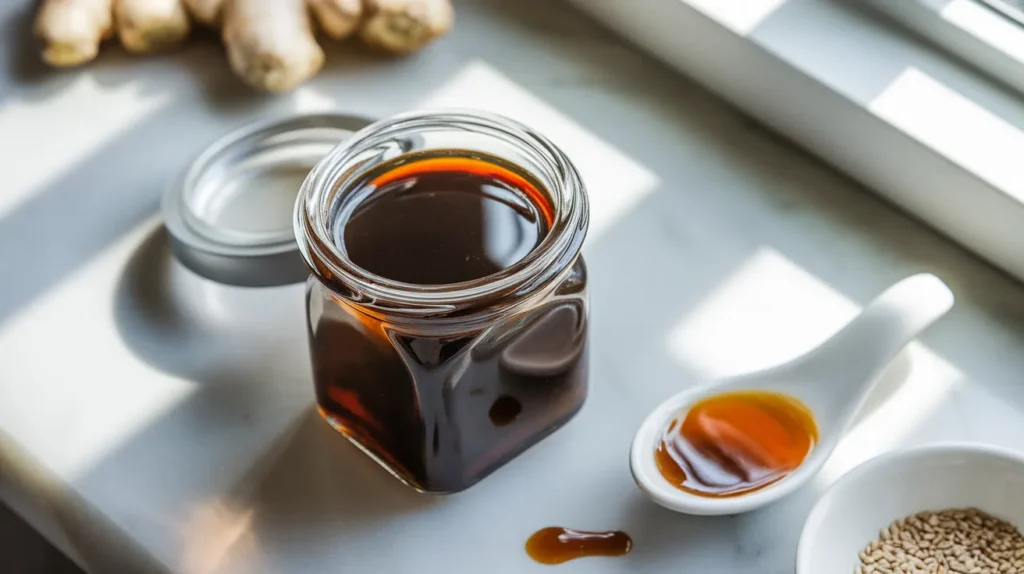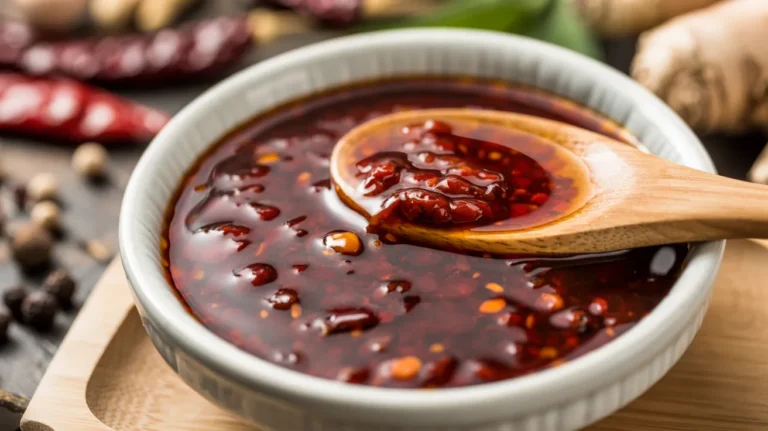This foolproof shoyu sauce recipe transforms simple ingredients into Japan’s most beloved condiment in just 20 minutes. Our step-by-step guide makes creating authentic shoyu sauce completely approachable for first-time cooks, delivering restaurant-quality results every single time.
SERVES: 4 | PREP: 10 MIN | COOK: 10 MIN | TOTAL: 20 MIN
Ingredients
Base Components
| Ingredient | Amount | Notes |
|---|---|---|
| Soy sauce (low sodium) | 1 cup | Use Kikkoman or Yamasa brand |
| Mirin | 3 tablespoons | Sweet rice wine, essential for authentic flavor |
| Rice vinegar | 2 tablespoons | Not regular white vinegar |
| Brown sugar | 2 tablespoons | Light brown works best |
Flavor Enhancers
| Ingredient | Amount | Notes |
|---|---|---|
| Fresh ginger | 1 tablespoon, grated | Must be fresh, not powdered |
| Garlic cloves | 3 cloves, minced | Choose firm, white cloves |
| Sesame oil | 1 teaspoon | Toasted sesame oil only |
| Kombu seaweed | 1 small piece (optional) | Found in Asian grocery stores |
Detailed Step-by-Step Instructions for Beginners
Phase 1: Getting Everything Ready (5 minutes)
- Clear your workspace completely. Remove everything from your counter except the ingredients and tools you need. This prevents confusion and accidents during cooking.
- Read through the entire recipe twice before starting. Understanding each step beforehand prevents mistakes that could ruin your shoyu sauce.
- Measure all ingredients into separate small bowls. This technique, called “mise en place,” ensures you don’t forget anything mid-recipe. Use measuring cups for liquids and measuring spoons for smaller amounts.
- Prepare your ginger properly. Use a spoon edge to scrape off the thin brown skin – this works better than a peeler. Then use the smallest holes on your grater to create fine shreds. Grated ginger should look like wet sawdust, not chunks.
- Mince garlic to the right size. Cut each clove in half, remove any green centers (they’re bitter), then chop into pieces smaller than rice grains. If pieces are too big, they won’t blend into your shoyu sauce properly.
Phase 2: Building Your Shoyu Sauce Base (3 minutes)
- Choose the right saucepan. Use a medium-sized, heavy-bottomed pan. Thin pans heat unevenly and can burn your sauce. The pan should be large enough that ingredients don’t splash when stirring.
- Pour soy sauce into the cold pan first. Never add soy sauce to a hot pan – it will splatter dangerously and create a bitter taste. The pan should be completely cool when you start.
- Turn heat to medium-low immediately. This is crucial – high heat will make your shoyu sauce taste burnt and bitter. You want gentle bubbles, not aggressive boiling. If you’re unsure about your stove’s heat levels, start with the lowest setting and increase gradually.
- Add mirin to the soy sauce slowly. Pour it down the side of the pan, not directly into the center. This prevents splashing and helps ingredients combine smoothly.
- Whisk in rice vinegar gently. Use a small whisk or fork to stir. The mixture should look uniform in color with no streaks or separation.
Phase 3: Sweetening and Balancing (4 minutes)
- Add brown sugar gradually while stirring constantly. Don’t dump all the sugar in at once – it will clump and won’t dissolve properly. Sprinkle it in while stirring continuously with your whisk.
- Watch for complete sugar dissolution. Keep stirring until you can’t see any sugar granules at the bottom of the pan. This usually takes 2-3 minutes of constant stirring. Undissolved sugar creates a gritty shoyu sauce.
- Test the temperature with your finger. The mixture should feel warm but not hot when you quickly dip your clean finger in. If it’s too hot to touch, reduce heat further.
- Add kombu seaweed if using. Drop the piece directly into the mixture. It will float at first, then sink as it absorbs liquid. This step adds authentic umami depth to your shoyu sauce.
Phase 4: Adding Aromatics (5 minutes)
- Stir in minced garlic first. Add it slowly while stirring to distribute evenly. You should be able to smell the garlic immediately – this means your temperature is correct.
- Add grated ginger next. Stir it in thoroughly so no clumps remain. Fresh ginger releases oils that enhance your shoyu sauce significantly.
- Bring mixture to a very gentle simmer. You want to see tiny bubbles around the edges of the pan, not vigorous bubbling in the center. This gentle heat develops flavors without burning delicate ingredients.
- Simmer for exactly 5 minutes while stirring every 30 seconds. Set a timer – this timing is crucial for proper flavor development. Stirring prevents ingredients from sticking to the pan bottom.
- Watch for color changes. Your shoyu sauce will gradually darken from light brown to deep amber. This color change indicates proper cooking and flavor concentration.
Phase 5: Final Touches and Cooling (3 minutes)
- Remove pan from heat completely. Turn off the burner and move the pan to a cool burner. This stops the cooking process immediately.
- Let mixture cool for exactly 2 minutes. Set a timer again – adding sesame oil to hot sauce will make it bitter. The sauce should still be warm but not steaming.
- Remove kombu seaweed if used. Use tongs or a fork to lift it out. The seaweed has done its job adding umami flavor to your shoyu sauce.
- Drizzle in sesame oil drop by drop while stirring. Don’t pour it all at once. Add a few drops, stir, add more drops, stir again. This creates proper emulsion.
- Taste your finished shoyu sauce carefully. It should be warm, not hot. The flavor should be balanced – salty, sweet, and savory. If too salty, add ½ teaspoon more brown sugar. If too sweet, add ½ teaspoon rice vinegar.
- Strain if desired for smooth texture. Pour through a fine mesh strainer into your storage container if you prefer completely smooth shoyu sauce. This removes any small pieces of ginger or garlic.
- Transfer to clean glass jar immediately. Use a funnel if you have one to prevent spills. Glass preserves flavor better than plastic containers.
Chef’s Notes for Perfect Shoyu Sauce
• Temperature is everything: Keep heat low throughout the entire process. High heat destroys the delicate balance that makes authentic shoyu sauce special.
• Quality ingredients matter: Premium soy sauce creates dramatically better results. Spend a little extra on Kikkoman or Yamasa brands.
• Fresh aromatics only: Powdered ginger and garlic simply won’t give you the bright, complex flavors of fresh ingredients.
• Patience pays off: This shoyu sauce tastes even better after resting overnight as all flavors meld together perfectly.
Nutrition Information (Per 2 tablespoon serving)
- Calories: 35
- Protein: 2g
- Carbohydrates: 6g
- Fat: 0.5g
- Sodium: 980mg
Creative Shoyu Sauce Variations
Spicy Fire Shoyu Sauce
Add 1 teaspoon red pepper flakes during simmering for heat lovers. This creates an excellent spicy condiment that works beautifully as a sauce for rotisserie chicken.
Sweet Teriyaki-Style Shoyu Sauce
Double the brown sugar and add 1 tablespoon honey for a glossy, sweet version perfect for glazing meats and vegetables.
Citrus-Bright Shoyu Sauce
Replace rice vinegar with fresh lime juice for a zesty twist that complements seafood and salads perfectly.
Mushroom-Rich Shoyu Sauce
Soak dried shiitake mushrooms in warm water, then add both mushrooms and soaking liquid for earthy complexity. This creates depth similar to miso sauce but with shoyu’s distinctive character.
Storage & Reheating Your Shoyu Sauce
Refrigerator Storage: Store your homemade shoyu sauce in an airtight glass jar for up to 3 months. Glass containers preserve flavor better than plastic and prevent absorption of refrigerator odors.
Freezing Guidelines: Not recommended as freezing changes the texture and separates the ingredients when thawed.
Serving Temperature: Serve at room temperature or slightly warmed. Cold shoyu sauce mutes the complex flavors you worked to develop.
Daily Use: Keep a small portion at room temperature for immediate use, storing the rest refrigerated.

Troubleshooting Your Shoyu Sauce
Problem: Sauce tastes overwhelmingly salty
Solution: Add 1 more tablespoon brown sugar and 1 teaspoon rice vinegar. Stir well and taste again. Repeat if needed until balanced.
Problem: Consistency is too watery
Solution: Return to low heat and simmer 3-5 more minutes to reduce and concentrate flavors. Stir constantly to prevent burning.
Problem: Unpleasant bitter aftertaste
Solution: You likely used too high heat. Unfortunately, this can’t be fixed – start over with lower temperature throughout.
Problem: Gritty or grainy texture
Solution: Strain through fine mesh sieve to remove undissolved sugar crystals or large aromatic pieces.
Problem: Sauce separates when stored
Solution: This is completely normal. Simply shake or stir before each use. Separation doesn’t affect flavor quality.
Essential Equipment for Making Shoyu Sauce
• Heavy-bottomed medium saucepan prevents hot spots and burning • Fine mesh strainer for silky smooth texture • Microplane or fine grater for ginger preparation • Sharp knife for precise garlic mincing • Small whisk for thorough mixing • Glass storage jar with tight-fitting lid • Measuring cups and spoons for accuracy
Complete Shopping List
Pantry Section
- Low sodium soy sauce (1 bottle)
- Mirin (rice wine section)
- Rice vinegar
- Light brown sugar
- Toasted sesame oil
Fresh Produce Section
- Fresh ginger root (buy extra for future batches)
- Fresh garlic bulbs
International/Asian Aisle
- Kombu seaweed (optional but recommended)
Five Success Secrets for Perfect Shoyu Sauce
- Invest in quality soy sauce – it comprises 80% of your final flavor, so premium brands make a noticeable difference in your shoyu sauce.
- Master low-heat cooking – patience during simmering develops the complex, layered taste that distinguishes homemade shoyu sauce from store-bought versions.
- Taste and adjust constantly – every soy sauce brand varies in saltiness, so adjust sweetness and acidity to achieve perfect balance.
- Allow proper resting time – your shoyu sauce improves significantly after sitting for several hours as flavors marry and develop.
- Make large batches – this shoyu sauce keeps excellently refrigerated, and having homemade available elevates every meal you prepare.




